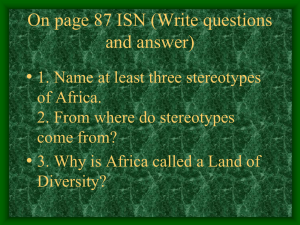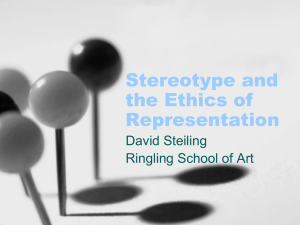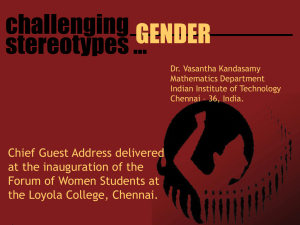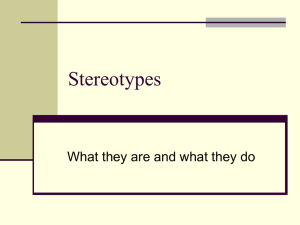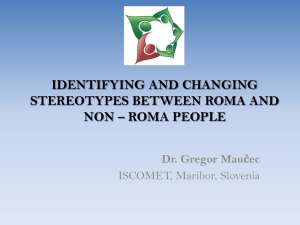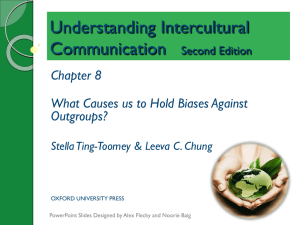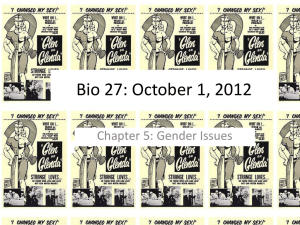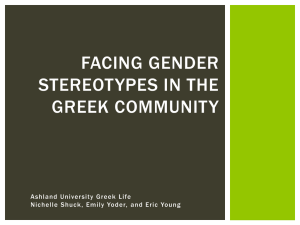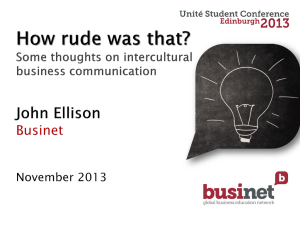Stereotypes
advertisement
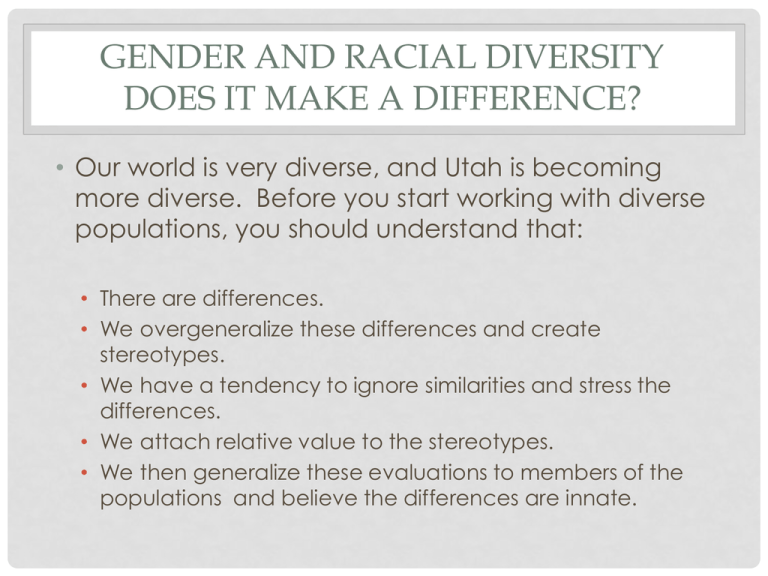
GENDER AND RACIAL DIVERSITY DOES IT MAKE A DIFFERENCE? • Our world is very diverse, and Utah is becoming more diverse. Before you start working with diverse populations, you should understand that: • There are differences. • We overgeneralize these differences and create stereotypes. • We have a tendency to ignore similarities and stress the differences. • We attach relative value to the stereotypes. • We then generalize these evaluations to members of the populations and believe the differences are innate. GENDER AND RACIAL DIVERSITY DOES IT MAKE A DIFFERENCE? • An Example • There are differences – African American males are more likely to commit crimes. • We overgeneralize these differences and create stereotypes – African American males are criminals. • We have a tendency to ignore similarities and stress the differences – We ignore the fact that middle class African American males and middle class White American males living in the same area are equally likely to commit crimes. • We attach relative value to the stereotypes. It is worse to be a criminal than to conform. • We then generalize these evaluations to members of the populations and believe the differences are innate. All African American males are bad because they are criminals. They are criminals, because they are African American. GENDER AND RACIAL DIVERSITY DOES IT MAKE A DIFFERENCE? • Who holds these stereotypes? • We do – often unconsciously. • Members of the minority groups often internalize stereotypes including the negative stereotypes attached to their own group. • Members of majority groups often internalize stereotypes. GENDER AND RACIAL DIVERSITY DOES IT MAKE A DIFFERENCE? • How do we overcome the tendency to stereotype? • Be consciously aware of our own biases. The first step is to recognize and acknowledge their existence. • Remind ourselves that different can be just that – different – not better or worse. • Remind ourselves that humans are ONE race. While each person is different, we are much more alike, than we are unalike. • Negate stereotypes whenever we can. For instance, stereotypes are often transmitted through jokes. We need to correct those who are telling these jokes. OUR GENDER STEREOTYPES ARE SO ENGRAINED THAT WE EVEN “GENDER” INANIMATE OBJECTS. A Can you categorize these objects as male or female? For instance, which car is male, and which is female? Which house is male and which is female? Which smiley face is male and which is female? B THIS TENDENCY TO GENDER INANIMATE OBJECTS IS PERVASIVE. A We even categories some animals as male and others as female – although obviously they are both male and female. B WE GENDER MUSICAL INSTRUMENTS. A B Male or female? Our children wear gendered colored clothing ALTHOUGH SOME SPORTS ARE NOW GENDER NEUTRAL, WE OFTEN GENDER SPORTS.. A B THE PLANTS WE PLANT, THE FOOD WE EAT, AND THE TYPES OF CLOTHES WE WEAR ARE OFTEN CLASSIFIED AS MALE OR FEMALE A B WE THINK OF DIFFERENT LANGUAGES AS MASCULINE OR FEMININE A B Even some letters are perceived as feminine or masculine. MOST PEOPLE CAN CLASSIFY THE HATS WE WEAR AND THE APPLIANCES WE USE AS MALE OR FEMALE. A B EVEN THE TOYS WE GIVE OUR CHILDREN ARE GENDERED. B A Blocks are often seen as male or female CERTAINLY WE GENDER OCCUPATIONS A Cook Building Construction Secretary Child Care Provider Principal Nurse Football Player Staff Psychology Professor Social Work Major B Restaurant Owner Interior Designer CEO Coach Kindergarten Teacher Doctor Figure Skater Faculty Engineering Professor Business Major GENDER STEREOTYPES – WHICH DO WE VALUE MOST – OR ARE THEY JUST DIFFERENT? Male Are Females Are Strong Stoic Leaders Rational Assertive Loud Competitive Weak Emotional Followers Irrational Passive Soft Cooperative RACIAL STEREOTYPES • We also have stereotypes associated with different racial groups. • These stereotypes are valued differently relative to each other. • The evaluation of the stereotype tends to diffuse over the entire group. • The language we use reflects, and reinforce these stereotypes and their relative value. RACIST STEREOTYPES WORDS ASSOCIATED WITH BLACK ARE DEFINED NEGATIVELY • Black and White Words Word Definition Blackly Blacken Black eye Blackballed Black outlook Black mark Black sheep Blacklist Blackmail angrily defame mark of shame ostracized pessimistic detrimental fact one who causes shame list of undesirables Force or coerce RACIST STEREOTYPES WORDS ASSOCIATED WITH WHITE ARE DEFINED POSITIVELY • Black and White Words Word Definition White Whiten White Wash White House White House White Lie White wedding dress pure brighten, clean cover imperfections President’s house executive branch of the government small, innocent lie depicts a virgin bride, innocent HISTORICALLY, “LOADED” WORDS REFLECTED THE RELATIONSHIP BETWEEN GROUPS AND WERE BIASED TOWARD THE MAJORITY GROUP • Columbus discovered America and conquered the savages. • Native Americans massacred the soldiers. • The soldiers conquered the Indians. • Settlers defended their lands. THE SAME STORIES COULD HAVE BEEN TOLD LIKE THIS: • Columbus found America and exploited the Indigenous population. • Native Americans conquered the soldiers. • The soldiers massacred the Indians. • Settlers forcibly took away their lands. DESCRIPTORS ARE ALSO REVEALING. • • • • • • • Squaws – not women Tribes – not nations Savages – not people Beasts – not humans Backward – not different Primitive – not different Buck – not man WHEN RACIAL GROUPS “SPEAK” ENGLISH IN MOVIES OR BOOKS, THEY ARE OFTEN RIDICULED. • Asian Characters say, • • • • “Honorable so and so” “Confucius say” “Very solly” “Flied lice” • Native Americans Characters say • “Boy not hide, Indian take boy” • “Heap big” • “UGH or HOW” POLITICALLY CORRECT TERMS • There is debate about “politically correct” language. • Some say using these terms can inhibit interaction/communication as politically correct terms change and people scramble to know what is politically correct • Some say that the terms change as these terms become associated with negative stereotypes. It is important that we resist using terms that divide, devalue and stereotype. TERMS WE USE Terms we USE Suggested Terms Culturally deprived Culturally dispossessed Economically Disadvantaged Economically Exploited Underdeveloped Overexploited Non-white People of Color Minority Third World Disabled People with Disabilities BOTTOM LINE (S) • We can tell a person’s race and gender almost immediately. • People are different. • We often take these differences and overgeneralize them to a racial or gender group. We stereotype. • We value stereotypes differently. • These valuations diffuse over all the members of the group. • The language we use reflects and reinforces these stereotypes. BOTTOM LINE(S) • When interacting with members of diverse groups, we need to be conscious of the words we use. • We need to chose words that do not reinforce stereotypes – but may reflect diversity. • We need to remember that different groups will perceive words differently. • Bottom Line—Remember words are powerful. • Use them carefully. CONTACT INFORMATION • Dr. Carol Albrecht • Assessment Specialist USU Ext • carol.albrecht@usu.edu • (979) 777-2421
